Covering a lot of ground in Missouri’s well-rounded college town where the university prevails over a city rich in history
Columbia, sometimes called “the Athens of Missouri,” has almost always been a college town. Located in Boone County, in the center of the state, where wide-open prairie begins to meld into Ozark hills, Columbia is virtually synonymous with the University of Missouri, MU for short, or the nickname Mizzou, which goes back more than a century. It’s one of three institutions of higher learning in the town.
Mizzou, with a student body of about 34,000, was established in 1839, less than two decades after the city was founded, and enjoys numerous claims to fame. It was the first state university west of the Mississippi and the first in Thomas Jefferson’s Louisiana Purchase (the third president’s original tombstone was given to the school by heirs in 1883). The first civil-engineering classes west of the Mississippi were offered here in 1849, and MU opened the world’s first journalism school in 1908.
The town’s other two schools of higher learning include Columbia College, with about 2,100 undergraduates, begun in 1851 as Christian Female College, the first for women west of the Mississippi (MU wasn’t fully open to women until 1871), and Stephens College, in the heart of downtown, with a student body of about 850. It was founded in 1833 as the Columbia Female Academy and today is the second oldest women’s college in the country.
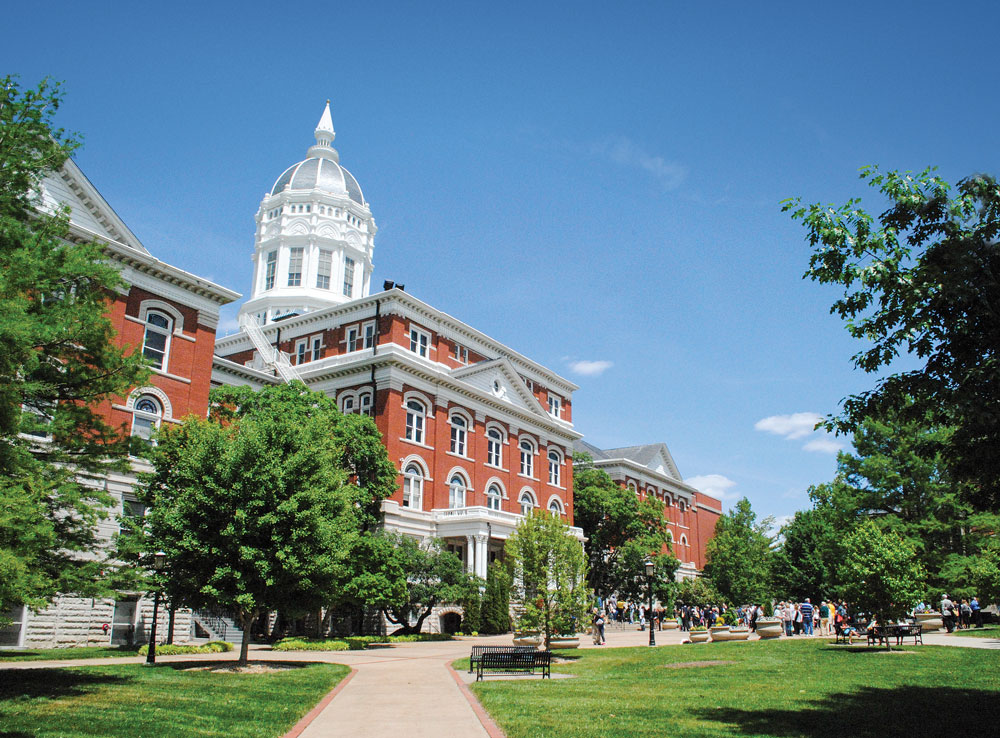
Majestic Jesse Hall is Mizzou’s administration building, built in 1893 after Academic Hall burned and left its six columns as the campus landmark.
My husband, Guy, and I live in St. Louis, just 125 miles east of Columbia, so it’s not surprising that many of our high school friends and a few relatives went on to university there. Because the town lies along Missouri’s main east-west corridor, Interstate 70, we’ve passed by many times en route to elsewhere. But until recently, we had never chosen Columbia as a destination — and didn’t know what we’d been missing.
The town of 120,000 is lovely, rich in history and culture, with a vibrant and growing community and plentiful attractions. There are the expected great restaurants (it’s a college town, after all), museums, parks, music and theater venues, and a bunch of festivals. And if you visit in the fall, there’s football, which is a big deal here. Part of the Southeastern Conference, the Mizzou Tigers play at Faurot Field, a stadium worthy of a professional team.
Guy and I have always wondered why the team is the Tigers and not the Mules, which seems more logical. Missouri has long been famous for its large, intelligent draft mules, bred in the state since a herd of donkeys was brought here from Mexico in the 1820s. It was a flourishing industry. The mule is the state animal.
On our recent four-day visit, Chris Campbell, director of the Walters-Boone County Historical Museum, explained why. During the Civil War, he said, when fighting in Missouri was intense, the university was shuttered and federal troops and officers occupied the buildings. Townspeople, struggling to keep their city out of Confederate hands, became known as “the fighting tigers of Columbia.” A quarter-century later, when the school’s football team was formed, an alumnus suggested Tigers, out of respect for those who had fought to defend the town, and the name was adopted.
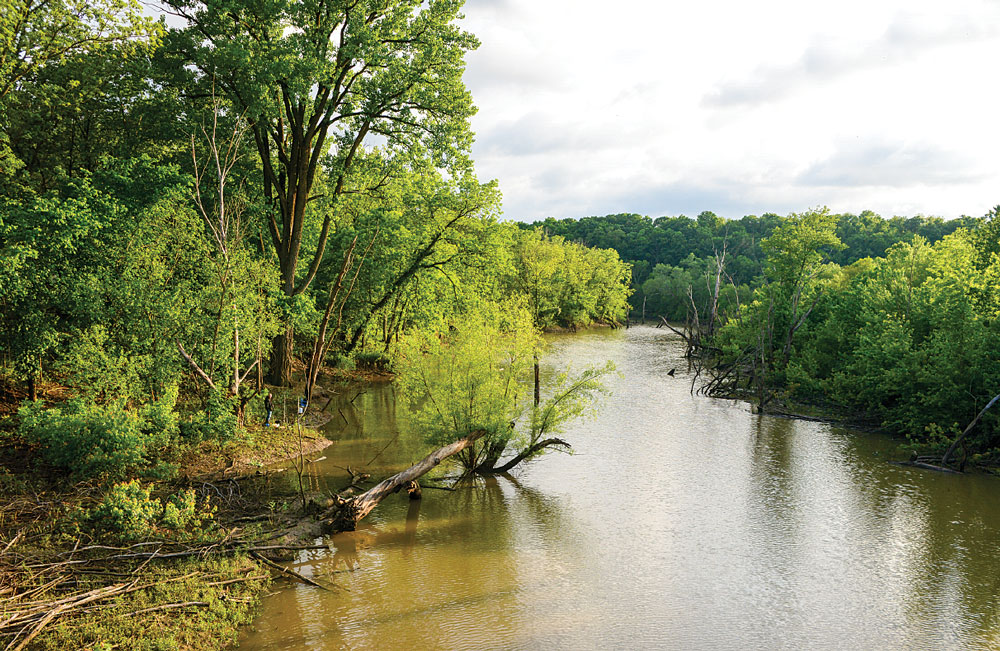
Sunset casts golden light on Moniteau Creek, a tributary of the Missouri River, in picturesque Rocheport just west of Columbia.
Higher Education
We began our visit with a walking tour of the University of Missouri’s imposing 1,262-acre campus. Many of the buildings are neo-Gothic, among them the 140-foot-tall Memorial Union, built in 1926 as a tribute to MU students and alumni lost in war. Francis Quadrangle, at the heart of the campus, is named for David R. Francis, governor of Missouri from 1888 to 1892. The quad includes white-domed Jesse Hall, MU’s oldest, and six stately columns, all that remain of Academic Hall, the school’s first building, which burned in 1892.
Sixteen years ago, the campus was transformed into Mizzou Botanic Garden, with 18 different gardens spread throughout, including the Siberian Iris Garden, Peony Garden, Butterfly Garden and others. All are bursting with showy blooms: roses, purple asters, coneflowers, delicately sweet pink peonies, Missouri-native ironweed, fuchsia-colored butterfly bush and many more.
Galleries and museums are spread across the campus, with exhibits for most any interest. For reptile enthusiasts (I’m one), there’s must-see Stewart Hall. Here, creatures peer quizzically (turtles) or indifferently (snakes) from aquariums populated with Mississippi mud turtles, rose-tinted painted turtles, timber rattlers and black king snakes, among some 30 species. The most unusual is Missouri’s largest salamander, an eel-like three-toed amphiuma, 24 inches of gray slither, which, said Exhibit Director Richard Daniel, inhabits the shallow, sluggish waters of the state’s southeasternmost part, the Bootheel.
Among art lovers, Missouri is noted particularly for two of its painters, George Caleb Bingham (1811 to 1879), born in Virginia but known as “the Missouri artist,” and Thomas Hart Benton (1889 to 1975) of Neosho. We visited the Bingham Gallery in the Fine Arts Center, which, despite the name, doesn’t display his work. Instead, exhibits are by students, faculty and others — on this occasion, “Friends from Isolation” by MFA candidate Joshua Maier. The dozen well-crafted “friends” are whimsical dachshund-size sea creatures made of painted clay.
Nearby, at the State Historical Society of Missouri within Ellis Library, paintings by Bingham are displayed, as are numerous works by Benton. Bingham was a politician as well as an artist, elected to the state legislature in 1848, then appointed state treasurer in 1862, before becoming MU’s first professor of art in 1877.
The society owns numerous Bingham works, and exhibits change at the 365-square-foot Bingham Room, said Joan Stack, curator of art collections. But the artist’s last major work, General Order No. 11, painted in 1863, is always on display. It was Bingham’s “painterly protest” against martial law on the Kansas-Missouri border during the war, when the hated order given by Union General Thomas Ewing forced the evacuation of some 20,000 Missourians from four border counties. Though a Unionist, Bingham promised to make Ewing, who appears in the painting, “infamous.”
Adjoining galleries display the stylized work of Benton’s World War II paintings (Starry Night, Casualty and Embarkation) and lithographs, among them the 1934 Plowing It Under and 1970 Mr. President, which portrays Harry Truman, another famous Missourian. In the corridor outside, a 320-foot “linear gallery” presents dozens of fine lithographs from the 1930s and ’40s by Missouri artist Ben Messick (1891 to 1981).
MU also offers museums of anthropology, art and archaeology, entomology and geology, plus the Glen Smart Waterfowl and Upland Game Bird Collection, as well as the Yeckel Collection, which displays animal specimens from Africa, Eurasia and North America.
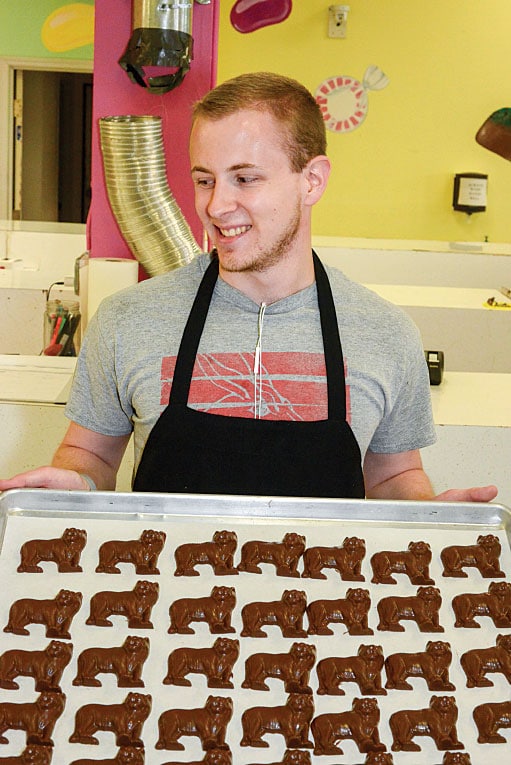
Chocolatier Aaron Schilb at the Candy Factory shows off chocolate tigers made for a Mizzou-themed party.
Galleries at Columbia College exhibit artwork by students, faculty and professional artists, and Stephens College Costume Museum and Research Library features rotating exhibits of more than 13,000 garments dating back to the mid-18th century.
Candy and Confections
The city guidebook we used lists the Candy Factory downtown as a must-see for kids, but whatever your age, you should visit. The 3,500-square-foot retail area is a magical candy world, with tables and shelves bearing every type of sugary treat you can imagine. Glass jars of jelly beans and lollipops, boxes of traditional chocolates, bins of chocolate-covered potato chips and pretzels, deep-dish chocolate pizza, chocolate Missouri maps and chocolate tigers (for Truman the Tiger, the Mizzou mascot), plus many others, are all festively displayed among candles, beaded bracelets, greeting cards, stuffed animals and much more.
Owner Michael Atkinson, who now runs the “factory” with his wife, Amy, and six full-time and 10 part-time employees, said it was started in 1974 by “home candy-maker” Georgia Lundgren and bought by his parents, Sam and Donna Atkinson, a dozen years later. It’s now located in a historic building the family bought in 1999.
Atkinson said jelly beans and lollipops are acquired elsewhere, but every chocolate item is made here in the 5,500-square-foot production area. At the viewing room, he pointed out the copper pots and marble-slab tables where chocolates are made daily “using a hundred-year-old method.” While we watched, Russell Testerman funneled hot liquid caramel through an extruder onto trays of chopped pecans for chocolate turtles. In another area, Aaron Schilb poured chocolate into plastic elephant and tiger molds.
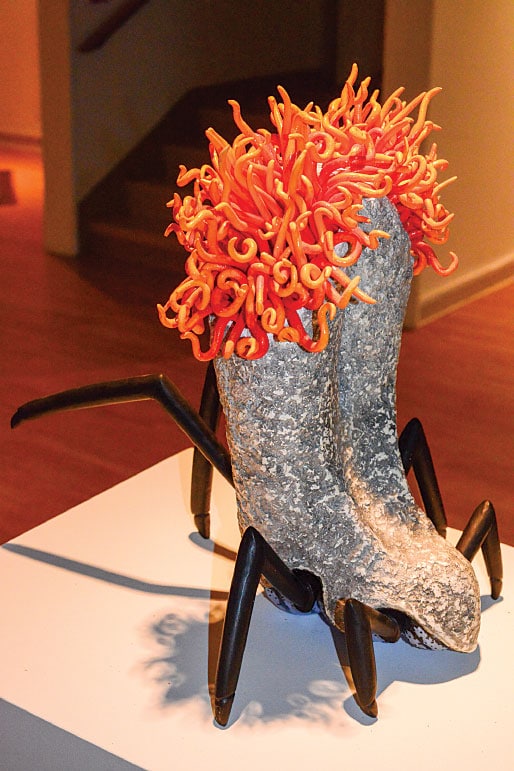
This strange creature of a fanciful ocean is part of the master’s degree project of University of Missouri student Joshua Maier.
The factory makes candy buffets for weddings, chocolate-covered strawberries for hotel favors and festive specialties for Christmas, Valentine’s Day, Easter and other holidays. This year for Father’s Day, Atkinson said they’ll offer something new: chocolate-covered bacon.
History, Parks and Preserves
We spent a pleasant afternoon at Boone County Museum and Galleries, located in 60-acre Frank G. Nifong Memorial Park and operated by the Boone County Historical Society. Director Campbell gave us some local history. In 1818, a group of settlers established the town of Smithton a mile or so from present-day downtown Columbia. However, due to lack of water, the site was soon moved, the name was changed, and in 1821 the new town was incorporated as Columbia. From the beginning, Campbell said, land was set aside for a university. The town grew quickly and continues to grow. “Economic foundations” are medicine and insurance, as well as education, though “it was the university that made Columbia what it is today,” he said.
The historical society manages Italianate Maplewood House, built in 1877 and now on the National Register of Historic Places (it was temporarily closed for renovations).
But the 5,500-square-foot Walters-Boone County Historical Museum was open, as was the 4,800-square-foot Montminy Art Gallery, where the work of local, regional and state artists is displayed — on this occasion, elegant plein art paintings by M. Shawn Cornell. The ornate 9-foot grand piano built in 1891 for local ragtime pianist and composer John William “Blind” Boone (1864 to 1927) is permanently in the gallery and is played during Blind Boone Piano Concerts.
The museum complex also includes River-Horse Pavilion, where the boat Nikawa (Osage for “river-horse”) is displayed. In 1995, Boone County author William Least Heat-Moon piloted the little craft along inland waterways clear across the continent. The Village at Boone Junction (open through October 30 this year for tours of four or more by appointment), comprised of four historic buildings, is nearby. The 1821 Gordon-Collins Log Cabin is believed to be the oldest surviving log building in the county. The 1890 Ryland Farmhouse is furnished with items typical to the era, and Easley Country Store, also from the 1890s, is a replica of a landmark on the banks of the Missouri River. The 1911 McQuitty “Shotgun” House was built by a local black contractor and realtor.
Columbia is unusual for its large expanse of parks and preserves (nearly 12,000 acres) including the Columbia Audubon Nature Sanctuary, Eagle Bluffs Conservation Area, Finger Lakes State Park, Rocky Fork Lakes Conservation Area, Three Creeks Conservation Area and Rock Bridge Memorial State Park. There’s also Katy Trail State Park. At 237 miles, the park is the country’s longest rails-to-trails project, spanning Missouri from Machens to Clinton, with 9 miles of the trail running through Columbia.
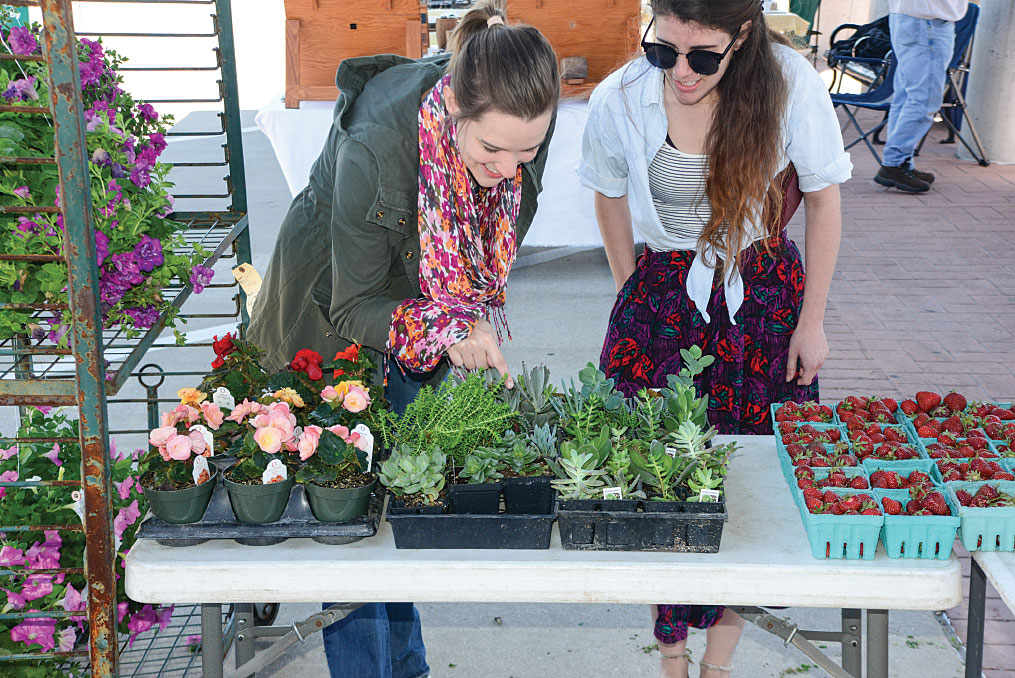
Shoppers look for flowers and homegrown goods at Columbia’s seasonal farmer’s market at Clary-Shy Community Park.
Our two dogs were finally able to enjoy Columbia with us at Rock Bridge Memorial Park, with its 2,273 acres of wooded rolling hills, more than two dozen miles of trails, and the eroded limestone wonders that are the bridge and Devil’s Icebox Cave. The 1⁄2-mile-loop Devil’s Icebox Trail, one of the park’s eight hiking trails, is a boardwalk with some serious ups and downs that leads through the woods to the cave.
I counted 45 steps on one ascent, 50 at another, 93 on a third, and there were many others. An engineering marvel, it is definitely not handicap accessible; in fact, our geriatric dogs had to be carried much of the way. But if you’re able, it’s an experience that shouldn’t be missed.
A steep descent leads to the low-vaulted cave, where inside the mouth, water gurgles over a jumble of rocks. Near the start of the trail, you can, if you like, walk under the massive stone bridge. Many up-and-down staircases later, you see the bridge’s other side from high up. A placard explains that at one time a rock roof extended from the bridge clear up the valley to connect with an enormous cave system. But long ago the cave roof collapsed, and today geologic processes continue to wear away the bridge.
Historic Rocheport
Our Columbia guidebook suggests a short drive to historic Rocheport (15 miles west on I-70), a quaint Missouri River town noted for its antique shops, a stretch of the Katy Trail and family-owned Les Bourgeois Winery, third largest of the state’s 125 wineries. Les Bourgeois wines range from dry to sweet, and tastings and tours are available.
We drove to Rocheport the last evening of our trip, and heartily recommend dinner at Les Bourgeois’ bluff-top Bistro for the view as much as the extensive menu and excellent wine. Two-story floor-to-ceiling windows provide sublime vistas of the river, which arcs off to the west, and the surrounding, thickly treed countryside. Through the windows, the only sign of civilization is a short, far-distant stretch of I-70, where vehicles the size of termites creep along.
Otherwise, this is what Lewis and Clark might have seen as they poled past more than 200 years ago, perhaps on a warm spring evening when the western sky was a temporary rainbow of purple, pink and turquoise, and the sun, just over the horizon, glittered through the trees like a kindly eye.

Beautiful Cottonwoods RV Park is lush with amenities and convenient to downtown and the MU campus. The park even offers borrow-a-book and borrow-a-DVD libraries.
If You Go
The Columbia Convention and Visitors Bureau Tourist Information Center is open weekdays from 8 a.m. to 5 p.m. at 300 S. Providence Road.
800-652-0987 | www.visitcolumbiamo.com
Cottonwoods RV Park
Open year-round, this Good Sam Park has 97 full-service sites, 63 of which are pull-through. Amenities include a convenience store, gift shop, playground, swimming pool, recreation room, free high-speed wireless internet and planned activities. Rates start at $40 per night.
573-474-2747 | 888-303-3313/reservations | www.visitmo.com/cottonwoods-rv-park

